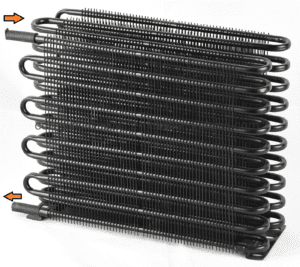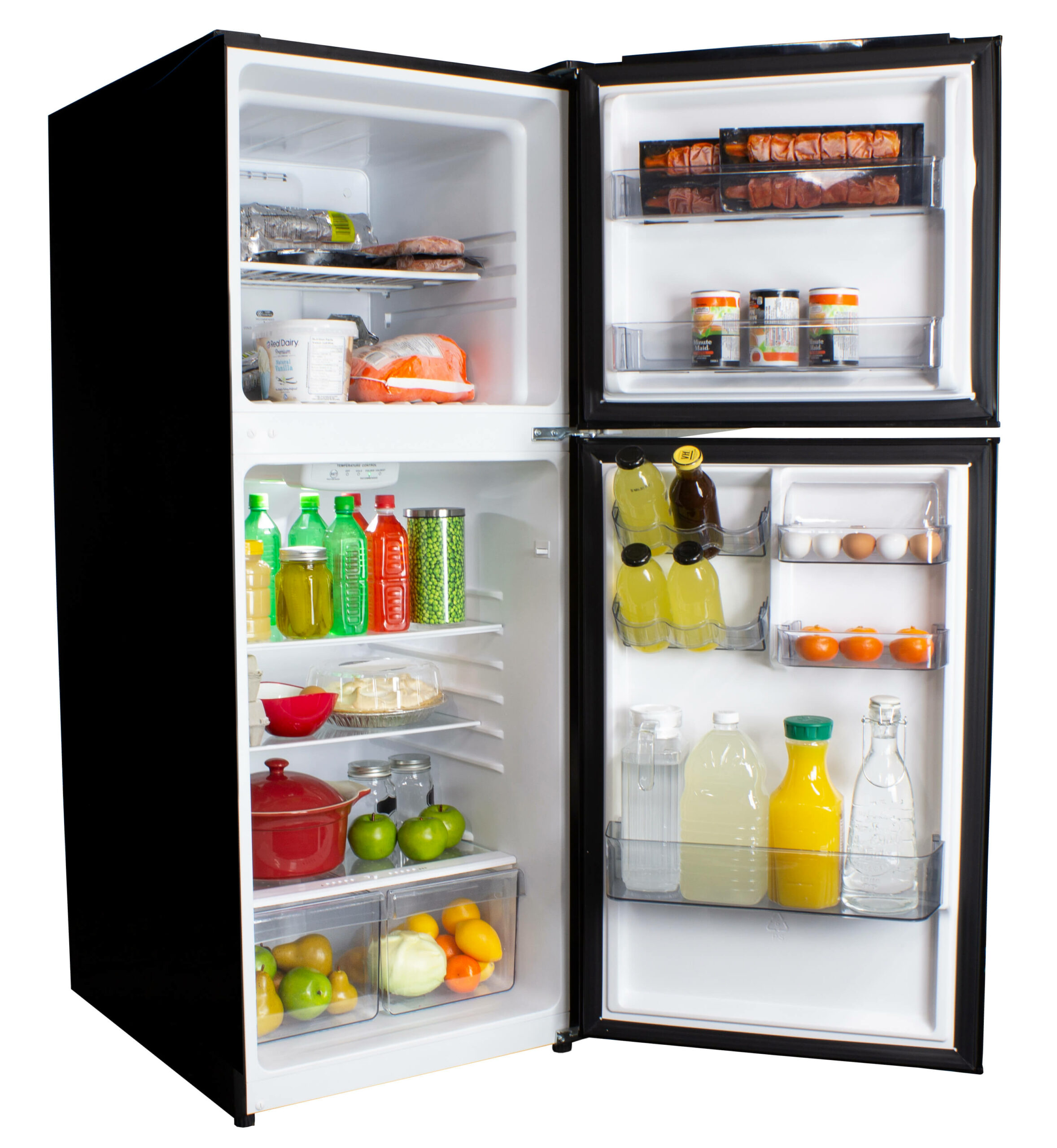What are 10 Cooling issues in Refrigerators?
- Refrigerators consist of evaporator coil, compressors, expansion coils and thermostat controls shown in the previous post.
- Cooling issues in a refrigerator can be caused by a variety of factors, and diagnosing and fixing the problem may require some troubleshooting.
- If you’re experiencing cooling issues with your refrigerator, it’s often best to consult the manufacturer’s manual for troubleshooting tips specific to your model.
- If the problem persists or you’re unsure about how to proceed, it’s recommended to contact a qualified appliance repair technician to diagnose and repair the issue.
- Attempting complex repairs without the necessary expertise can lead to further damage and safety hazards.
- Here are some common cooling issues in refrigerators:
- Uncleaned Condenser Coil
- Thermostat Problems
- Evaporator Fan Issues
- Damaged or Worn Door Seal
- Blocked Air Vents
- Refrigerant Leak:
- Faulty Compressor
- Electronic Control Board Malfunctions
- Overloading the Refrigerator
- Power Supply Issues:
Dirty Condenser Coils
- The condenser coils are responsible for releasing heat from the refrigerator.
- If they are dirty or clogged with dust and debris, they can’t dissipate heat effectively, leading to poor cooling performance.
- Regularly cleaning the coils can help resolve this issue.

Dirty condenser coils are a common cause of cooling problems in refrigerators. Here’s more information on this issue:
What are condenser coils?
- Condenser coils are part of the refrigeration system in a refrigerator.
- They are usually located on the back or underneath the appliance. The primary function of these coils is to release heat from the inside of the refrigerator into the surrounding air. This heat exchange process is essential for maintaining a cold temperature inside the fridge.
Why do dirty condenser coils cause cooling issues?
When condenser coils become dirty or covered in dust and debris, they can’t effectively release heat. As a result, the refrigerator’s cooling system has to work harder to maintain the desired temperature. This increased workload can lead to several issues:
- Inefficient Cooling:
- The refrigerator may struggle to cool properly, and the temperature inside may rise, leading to food spoilage.
- Higher Energy Consumption:
- When the compressor and cooling system have to work harder, the refrigerator consumes more energy, which can lead to increased electricity bills.
- Compressor Overheating:
- The compressor, which is responsible for compressing the refrigerant gas and maintaining the cooling cycle, may overheat if the condenser coils are dirty.
- This can lead to compressor damage and potentially costly repairs.
How to clean condenser coils:
- Cleaning the condenser coils is a relatively simple maintenance task that can improve the efficiency and lifespan of your refrigerator. Here are the steps to clean them:
- Safety First: Before you start, unplug the refrigerator or turn off its power source to ensure safety.
- Locate the Coils: Depending on your refrigerator’s design, the condenser coils may be on the back, underneath, or behind a kick plate at the front. Refer to your refrigerator’s manual if you’re unsure about their location.
- Remove Debris: Use a brush, vacuum cleaner with a brush attachment, or compressed air to remove dust, dirt, and debris from the coils. Be gentle to avoid damaging the coils.
- Clean the Area: While you’re at it, clean the area around the coils and the refrigerator’s surroundings to prevent dust buildup in the future.
- Plug It Back In: Once the coils are clean, plug the refrigerator back in or turn on the power source.
- Check for Improved Cooling: Monitor the refrigerator’s temperature over the next few hours to see if there’s an improvement in cooling performance.
- It’s a good practice to clean the condenser coils at least once or twice a year to ensure your refrigerator operates efficiently.
- Regular maintenance like this can help extend the life of your appliance and save energy.

Thermostat Problems in Refrigerator
- Thermostat problems in a refrigerator can disrupt its ability to maintain the desired temperature.
- The thermostat is responsible for regulating the cooling cycle of the refrigerator to keep the interior at the set temperature.
- When it malfunctions, it can result in cooling issues. Here are some signs and solutions for thermostat problems in a refrigerator:
Signs of Thermostat Problems:
- Inconsistent Temperature: The refrigerator may become too cold or too warm, and the temperature may fluctuate significantly.
- Food Spoilage: Food stored in the refrigerator may spoil prematurely due to temperature variations.
- Frozen Items: If the refrigerator becomes too cold, items stored near the thermostat sensor may freeze, even if they’re not in the freezer compartment.
- Inaccurate Temperature Control: Adjusting the thermostat settings doesn’t seem to have any effect on the refrigerator’s temperature.
Solutions for Thermostat Problems:
- Check the Thermostat Setting: First, ensure that the thermostat control knob or digital display is set to the desired temperature. Sometimes, accidental adjustments can lead to cooling issues.
- Inspect the Sensor:
- The thermostat usually has a temperature sensor (a bulb or probe) that monitors the refrigerator’s internal temperature.
- Make sure this sensor is in the correct position and not damaged. It’s often located in the upper rear of the refrigerator compartment.
- Calibrate the Thermostat (if possible):
- Some refrigerators allow you to calibrate the thermostat to ensure it accurately reflects the internal temperature.
- Check your refrigerator’s user manual for instructions on how to do this.
- Reset the Thermostat: If your refrigerator has a reset button for the thermostat, try resetting it. This can sometimes resolve minor issues.
- Test the Thermostat:
- To determine if the thermostat is faulty, you can perform a basic test.
- You’ll need a thermometer or a temperature sensor.
- Place it in a glass of water in the refrigerator, and leave it for several hours. Then, check the temperature reading.
- If it significantly deviates from the set temperature, it may indicate a faulty thermostat.
- Replace the Thermostat:
- If you suspect that the thermostat is the problem and it’s not functioning correctly, it may need to be replaced.
- This is typically a job for a qualified appliance repair technician, as it involves electrical components and wiring.
- Consult a Professional:
- If you’re unsure about diagnosing or repairing thermostat issues, or if you’ve tried the above steps without success, it’s advisable to contact a professional technician.
- They can accurately diagnose the problem and replace the thermostat if necessary.
- Thermostat problems can lead to temperature instability in your refrigerator, which can impact food safety and quality.
- Addressing these issues promptly is essential to keep your refrigerator functioning correctly.

Faulty Compressor in Refrigerator
- A faulty compressor is a significant and costly issue in a refrigerator.
- The compressor is a critical component of the refrigeration system responsible for compressing the refrigerant gas, raising its temperature, and then expelling it into the condenser coils to release heat.
- When the compressor fails, it can lead to cooling problems in the refrigerator.
- Here’s what you need to know about a faulty compressor:
Signs of a Faulty Compressor:
- Inadequate Cooling: The refrigerator fails to cool properly, and the temperature inside rises significantly.
- Clicking or Buzzing Sounds: You may hear clicking or buzzing noises coming from the back of the refrigerator, which could indicate the compressor is trying to start but failing.
- Hot Compressor: If you touch the compressor, it may feel excessively hot, indicating it’s running continuously and struggling to cool.
- Food Spoilage: Food stored in the refrigerator may spoil due to the lack of proper cooling.
- Freezer Compartment Issues: If the refrigerator has a separate freezer compartment, it may also exhibit temperature problems or stop freezing items.
Solutions for a Faulty Compressor:
- Consult a Professional:
- A faulty compressor is a complex and specialized component to repair or replace.
- If you suspect a problem with the compressor, it’s advisable to contact a qualified appliance repair technician.
- They will have the tools and expertise to diagnose the issue accurately.
- Compressor Replacement:
- If the technician confirms that the compressor is indeed faulty, it may need to be replaced.
- Compressor replacement is a costly repair and involves removing the old compressor, installing a new one, and recharging the refrigerant system.
- It’s typically not a DIY job due to the technical skills and equipment required.
- Consider Warranty or Service Agreement:
- If your refrigerator is still under warranty or you have an extended service agreement, the repair or replacement of the compressor may be covered.
- Check with the manufacturer or your warranty provider for details.
- Evaluate Repair Costs:
- Before proceeding with a compressor replacement, consider the age and overall condition of your refrigerator.
- In some cases, if the appliance is old and other components are also showing signs of wear,
- it might be more cost-effective to invest in a new refrigerator rather than a costly compressor replacement.
- A faulty compressor is a significant issue that can render your refrigerator inoperable.
- It’s essential to address this problem promptly to prevent food spoilage and ensure the continued functionality of your appliance.
- Consulting a professional technician is the best course of action to diagnose and resolve compressor issues.

Evaporator Fan Issues in Freeze
- Evaporator fan issues in a freezer can disrupt its ability to maintain a consistently cold temperature.
- The evaporator fan is responsible for circulating cold air throughout the freezer compartment, ensuring that items are frozen uniformly.
- When there are problems with the evaporator fan, you may encounter various cooling-related problems.
- Here’s what you need to know:
Signs of Evaporator Fan Issues:
- Uneven Freezing: Items in the freezer may freeze unevenly, with some parts being overly frozen while others remain thawed.
- Increased Frost Buildup: Excessive frost or ice buildup in the freezer may occur, especially around the evaporator coils. This can be a sign of poor air circulation caused by a malfunctioning fan.
- Temperature Fluctuations: The freezer may have difficulty maintaining a consistent temperature, leading to fluctuations in coldness.
- Strange Noises: You may hear unusual noises, such as buzzing or rattling, coming from the freezer. These noises can be a result of a faulty fan motor.
Solutions for Evaporator Fan Issues:
- Inspect and Clean the Fan Blades:
- Sometimes, debris or ice buildup can obstruct the movement of the evaporator fan blades.
- Unplug the freezer and carefully inspect the fan area. If you notice any obstructions, remove them.
- Be cautious not to damage the fan blades in the process.
- Check for Motor Problems:
- If the fan blades are not obstructed but the fan is not running or is making unusual noises, the fan motor may be faulty.
- You may need to replace the fan motor.
- Test the Fan:
- To determine if the fan is working properly, you can try spinning the blades manually.
- If they spin freely and the fan doesn’t start running, it’s likely a motor issue.
- If the blades are difficult to turn, it may indicate an obstruction or motor failure.
- Defrost the Freezer:
- Excessive frost buildup can impede the fan’s operation.
- If you notice frost accumulation, defrost the freezer by turning it off, removing the food, and allowing the ice to melt naturally.
- Once it’s fully defrosted, plug it back in and see if the fan starts running.
- Replace the Fan Motor:
- If the fan motor is found to be faulty, it’s recommended to replace it. Replacement fan motors are available for specific freezer models, and this repair may require some disassembly of the freezer interior. If you’re not comfortable with DIY repairs, consult a professional technician.
